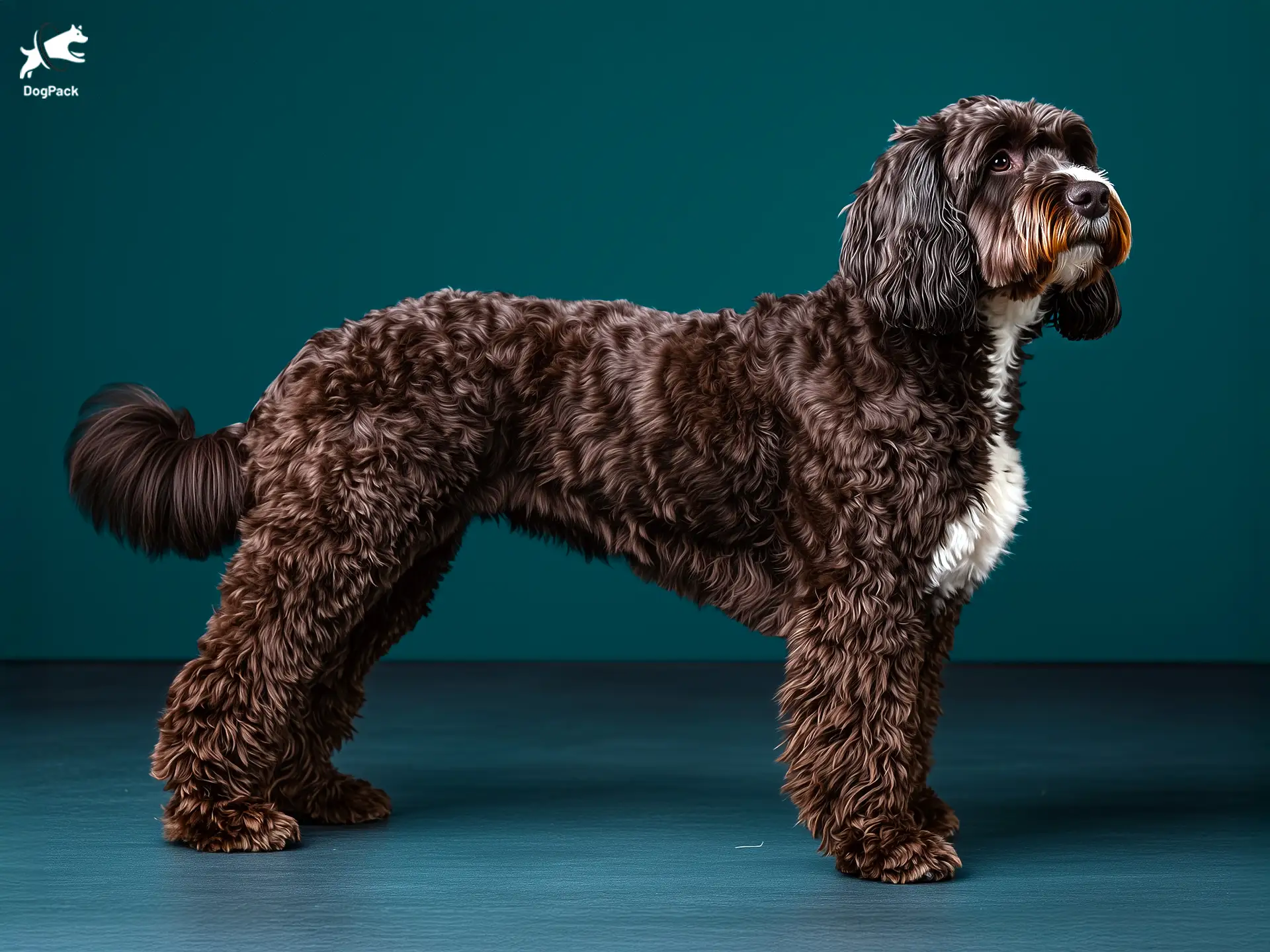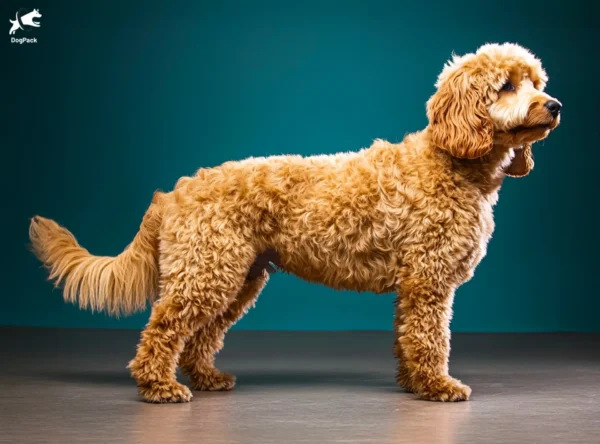Newfypoo Dog Breed Info & Overview
Bred as a clever combination of Newfoundland and Poodle, the Newfypoo brings a dash of gentle spirit wrapped in a large, huggable package. Calm yet full of sweet surprises, this pup stands out for its devoted nature and occasional bursts of silly humor. Whether you’re seeking a family protector or a friendly companion, this breed has a heart as big as its paws.
Characteristics
Pictures
Breed History
The Newfypoo traces its roots to a desire for a large, loyal companion that also carries the low-shedding qualities of the Poodle. By crossing the giant-yet-gentle Newfoundland with a clever Poodle, breeders hoped to create a dog that could double as a working partner and a devoted family friend. Over time, these pups gained popularity for their sweet disposition and versatile skill set.
While the exact origin date is a bit fuzzy, this crossbreed likely took off in North America during the “designer dog” boom. Newfoundland ancestors were originally used for heavy labor, pulling carts or hauling fishing nets, while Poodles were famed for their retrieving abilities and sharp intelligence. This blend of backgrounds helped shape an adaptable canine with a strong work ethic and a loving heart.
Today, many people seek the Newfypoo for companionship and family life. Although not officially recognized by major kennel clubs in the same way as purebreds, the breed still captivates dog lovers worldwide. Histories of these pups often highlight stories of them snuggling with children or happily trotting alongside active owners. Whether aiding in therapy or brightening someone’s day, they remain a testament to purposeful crossbreeding.
Temperament, Personality
Friendly and warm, these dogs typically greet loved ones (and even strangers) with tail-wagging enthusiasm. Their calm yet playful demeanor helps them fit in with families who enjoy moderate activity. Despite their large size, they often see themselves as lapdogs—ready to plop down for a belly rub or a good cuddle. Patience is another hallmark, particularly with younger children who might tug or climb.
While energy levels can vary from pup to pup, a Newfypoo usually has bursts of spirited play balanced by moments of laid-back relaxation. Most are naturally gentle, but early socialization is key to ensuring positive interactions with unfamiliar people and pets. They often form tight bonds with their human “pack,” which can lead to a bit of shadowing around the house or yard.
If you’re looking for a faithful companion that loves to tag along on adventures or snooze at your feet, this breed might be the one. Protective instincts can surface if they sense danger, but aggression is rare. With a sweet disposition and a love for goofy antics, these dogs are as likely to charm new friends as they are to guard their family from perceived threats.
Physical Characteristics
Thanks to their Newfoundland heritage, these dogs often boast a sturdy frame, broad chest, and large, expressive eyes. Their big paws are usually a telltale sign of their substantial size, while their coats can range from wavy to curly depending on the Poodle genes. Though traditionally black or brown, other coat colors—like cream, grey, or parti—sometimes appear, adding to their unique, showstopping appeal.
Standing anywhere between 20 and 28 inches tall, with weights hovering between 50 and 75 pounds, they certainly fill a room both in size and presence. Their ears typically flop forward, framing a gentle expression that seems to beam kindness. Leg length and body proportions can lean toward either the Newfoundland’s bulk or the Poodle’s sleek elegance, making each individual dog slightly different.
One of the breed’s signature traits is its coat density, which offers plush softness and a tendency toward mild shedding. Some pups will have more of a “doodle” appearance, while others resemble miniature bears. Regardless of the exact look, they exude an unmistakable, huggable charm. Families are often won over by their teddy-bear vibe, making it hard not to shower them with affectionate pats and scratches.
Health Issues
As with many large dogs, these pups can be prone to joint troubles, such as hip or elbow dysplasia. Regular vet checkups and early screening go a long way toward spotting any skeletal issues before they worsen. It’s wise to stay alert for signs of limping, stiffness, or discomfort when jumping or climbing stairs, as timely intervention may help keep those joints happier, longer.
Heart conditions like subvalvular aortic stenosis sometimes appear due to the Newfoundland side, so maintaining a healthy lifestyle is crucial. Monitoring weight, ensuring a balanced diet, and providing moderate exercise can all contribute to improved cardiovascular health. Of course, working with a reputable breeder who tests for these conditions significantly reduces the likelihood of serious complications arising.
A Newfypoo may also inherit skin sensitivities or ear infections, given their floppy ears and sometimes-dense coat. Routine grooming, drying ears after water play, and regular veterinary checks are effective ways to ward off bacterial or yeast issues. By combining consistent preventive care with a watchful eye for abnormalities, owners can help these gentle giants live their best lives free from unnecessary discomfort.
Grooming Needs
Depending on coat texture, brushing at least two to three times a week is essential to prevent matting, tangles, and excessive shedding. An undercoat that leans toward Newfoundland plush may require more intense grooming, especially during seasonal changes. Meanwhile, Poodle-like curls will still need routine combing to ensure you don’t miss any snags hiding beneath the surface layer of fluff.
Regular baths are beneficial but be careful not to overdo it and strip the coat’s natural oils. A gentle shampoo formulated for curly or wavy hair often works best. After a bath, thorough drying—sometimes with a dog-friendly dryer—helps discourage moist spots that can foster skin irritations. If you’re not comfortable with all the maintenance, professional grooming every 6–8 weeks can keep their coat in tip-top shape.
Ears require special attention: a quick check and wipe each week will go a long way in preventing infections. Trimming nails once or twice a month ensures comfortable movement, while daily toothbrushing supports overall dental health. Keeping up with these tasks not only helps your home stay relatively fur-free, but also ensures a Newfypoo’s coat and skin remain healthy and free from pesky knots or hotspots.
Exercise Requirements
Because they inherit energy from the Poodle side, these dogs appreciate a solid daily walk or romp in the yard. Aim for at least an hour of cumulative exercise, broken into a couple of sessions if needed. Thanks to their Newfoundland roots, they often excel in water-based activities. Many enjoy a splash in the pool or a safe swim at the lake, especially on warm days.
Adventures like moderate hikes or leisurely jogs can help keep them physically and mentally stimulated. They also benefit from puzzle toys or obedience work that challenges their sharp minds. When not exercising, they typically relax indoors with a content demeanor, provided they’ve had a chance to burn off energy. This balance between goofball antics and gentle downtime is part of their widespread appeal.
Like any large breed, these pups should not be overexerted as growing puppies—too much strain on young joints can lead to issues later. Gradually increase activity levels, allowing them to build strength and stamina at a healthy pace. If properly channeled, a Newfypoo’s energy can be a joy, whether it’s playing fetch, practicing tricks, or simply taking an evening stroll around the neighborhood.
Training Tips
These dogs are known for their eagerness to please, which makes consistent, positive reinforcement training highly effective. Tasty treats or enthusiastic praise usually motivate them to learn new commands. Because they crave human interaction, they often respond well to gentle guidance and correction rather than harsh discipline. However, it’s important to establish rules early, so their size doesn’t become an unintended obstacle in the home.
Socialization from puppyhood helps them grow into calm, confident adults. Introducing them to a variety of people, pets, and environments increases their comfort level and reduces any potential anxiety. Enrolling in group training classes—if available—can be a great way to reinforce good behavior under guidance. Pair training sessions with plenty of play, and you’ll likely see rapid improvements in obedience and manners.
Keep sessions fun yet structured by mixing short bursts of training with quick breaks. This breed’s intelligence means they enjoy mental challenges, such as advanced tricks or agility exercises that boost focus. Reinforcing commands like “stay,” “come,” or “leave it” can be crucial for a large dog. Once a Newfypoo understands their boundaries, they transform into a well-behaved family member who’s always excited to learn more.
Nutrition, Diet
Feeding a Newfypoo typically involves 3–4 cups of high-quality kibble per day, split into two meals. Look for large-breed formulations packed with joint-supporting nutrients like glucosamine and chondroitin. This helps support those hefty bones and hips. Some owners opt for diets that incorporate salmon or fish oils to promote healthy coat and skin, which can be a bonus for pups with wavier or curly fur.
Avoid overfeeding—excess weight can stress their joints and cardiovascular system. Monitoring body condition is essential: you should be able to feel, but not see, their ribs. Adding fresh fruits or vegetables (like sweet potatoes or peas) can provide additional vitamins while keeping meals interesting. Always confirm any specific dietary switch with a vet to ensure the pup’s unique nutritional needs are met.
Some dogs may do well with a home-cooked meal plan that includes lean proteins such as turkey or chicken, mixed with fibrous veggies and a bit of rice. If using raw or homemade diets, balance is crucial. Supplements like probiotics or fish oil may also offer benefits. Paying close attention to portion sizes and consulting with professionals can help maintain a healthy, robust Newfypoo for years to come.
Adoption, Breeders
When searching for a Newfypoo, start by considering adoption from rescue organizations dedicated to large dog breeds or doodle mixes. Check out websites like Petfinder for regional listings. Adopting an older dog can be a rewarding experience, especially for folks who want a calmer companion without the intensity of puppy training. Always ask about health checks before finalizing.
If you prefer going through a breeder, choose one who performs thorough health screenings on both parents. They should provide documentation of genetic tests for hip, heart, and other conditions relevant to this cross. Reputable breeders are happy to show their facilities and answer detailed questions about puppy care. It’s also worth exploring communities like Newfypoo Club of America for additional insights and reputable referrals.
Responsibility in choosing where to adopt or buy a puppy helps ensure you bring home a well-adjusted, healthy companion. Look for breeders who emphasize early socialization, whether it’s exposure to various household noises or positive interactions with children. The extra effort can really pay off in a pup’s confidence and overall temperament. Patience is key—waiting for the right source often results in a more harmonious match.
Family Pet?
Many families adore this breed for its loving, kid-friendly nature. They tend to be gentle around children, though supervision is always wise, given their large size. Whether it’s playing tag in the backyard or offering soothing companionship after a busy day, they shine in a bustling household. They’re typically happy to share the sofa (or the floor) once they’ve had enough activity.
Patience and a nurturing mindset make them a solid choice for multi-pet homes, especially when introduced gradually. Cats may be tolerated well, though a playful, curious dog could still give a feline reason to retreat. Ties to the Newfoundland’s historical role as a working dog mean they’re eager to “help” around the house—sometimes literally following family members room to room.
Given the gentle temperament, it’s no surprise that many see this cross as an ideal option for households with little ones or for extended family visits. They often serve as a reassuring presence, leaning in for pets or resting their head in a child’s lap. While each dog has unique quirks, a properly socialized Newfypoo can deliver the comforting vibe families seek in a four-legged friend.
Right For You?
If you’re longing for a low-shedding yet big-hearted companion, this breed might check all the boxes. They’re wonderful for individuals or families who appreciate daily walks and can handle a large, somewhat powerful dog. People who enjoy grooming or don’t mind scheduling regular salon visits may also find them a perfect fit. Their playful disposition requires some space, so tiny apartments can pose a challenge.
Prospective owners should note that early training is essential—living with a giant dog that ignores commands can be stressful. Time and patience spent on socialization ensure they become well-rounded family members. If you prefer a sedentary lifestyle and minimal grooming, this breed might demand more effort than you’d like. But for those committed to providing exercise, attention, and love, the result is a deeply devoted companion.
Ultimately, weighing factors like budget (for food and grooming), available outdoor space, and personal energy levels can help determine if this cross is your ideal match. They thrive best in an environment where they can engage in moderate to high activity and soak up plenty of affection. If you can offer that, there’s a good chance this cuddly, enthusiastic dog will become your loyal, life-long friend.
Conclusion
Spending time with a Newfypoo can feel like receiving a daily dose of warmth and humor, thanks to their gentle soul and playful spark. Those who prioritize a big, friendly companion ready for both adventures and snuggles may find them downright irresistible. Ultimately, offering consistent grooming, moderate exercise, and abundant affection helps ensure that this lovable crossbreed flourishes, bringing mountains of joy into any home.
FAQs
-
How does the Newfypoo’s swimming ability compare to a purebred Newfoundland?
The Newfypoo inherits strong swimming instincts from the Newfoundland, but their coat type affects buoyancy. A wavier, Poodle-like coat may reduce water resistance, while a thicker, Newfoundland-like coat provides better insulation. Either way, they excel in water rescue activities and love swimming.
-
Is the Newfypoo prone to excessive drooling like a Newfoundland?
Newfypoos drool significantly less than purebred Newfoundlands, thanks to their Poodle genetics. However, if they inherit the Newfoundland’s loose jowls, mild drooling after drinking water or eating may still occur. Regular grooming around the mouth helps keep them clean and dry.
-
How does a Newfypoo’s temperament compare to other Doodle breeds?
Unlike smaller Doodle breeds, the Newfypoo is exceptionally calm and gentle, often being more laid-back than a Goldendoodle or Labradoodle. Their protective but affectionate nature makes them excellent therapy and emotional support dogs, as well as fantastic family companions.
-
Can a Newfypoo handle hot climates?
Newfypoos tolerate heat better than purebred Newfoundlands due to their mixed coat, but they are still sensitive to extreme temperatures. Owners in warm regions should provide shade, water, and avoid intense exercise during peak heat to prevent overheating.
-
Are Newfypoos recognized by any official dog breed organizations?
Since the Newfypoo is a designer hybrid, it is not recognized by major kennel clubs like the AKC or FCI. However, hybrid registries such as the Designer Breed Registry (DBR) and American Canine Hybrid Club (ACHC) acknowledge the breed.
Breed Ratings
The Newfypoo quickly picks up commands, showing a bright and curious mind.
They love interactive games and can be quite goofy when engaging with family.
The Newfypoo is moderately energetic, enjoying walks and play while also savoring downtime.
Though part Poodle, they can still shed moderately, so regular grooming is beneficial.
Not typically focused on chasing, but they might get curious about smaller critters.
Thick coats require consistent care and occasional professional grooming.
Motivated by praise and treats, they respond well to positive reinforcement.
Strong bonds mean they can struggle with loneliness if left for long.
Generally quiet, but they will alert if something seems off.
Less slobbery than a pure Newfoundland, but mild drool still possible.
With early socialization, the Newfypoo typically gets along well with other dogs.
Prone to some large-breed concerns; preventive care is key.













